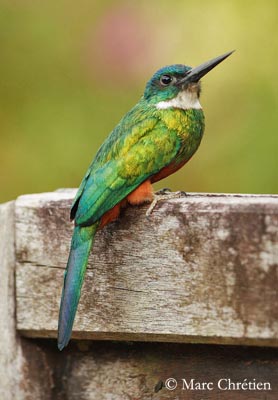
Green-tailed Jacamar
Galbula galbula
Piciforme Order – Galbulidae Family
BIOMETRICS :
Length : 18-22 cm
Weight : 18-29 g
Fr: Jacamar vert
All : Grünschwanz-Glanzvogel
Esp : Jacamará Coliverde
Ital : Jacamar codaverde
Nd : Groenstaart-glansvogel
Russe : Зеленая якамара
Photographs by Patrick Ingremeau
His website : TAMANDUA
Photographs by Marc Chrétien
His website : MURINUS
Text by Nicole Bouglouan
Sources :
A GUIDE TO THE BIRDS OF COLOMBIA by Steven L. Hilty and William L. Brown
Princeton University Press – ISBN 069108372X
HANDBOOK OF THE IRDS OF THE WORLD Vol 7 by Josep del Hoyo-Andrew Elliott-Jordi Sargatal - Lynx Edicions - ISBN: 8487334377
Arthur Grosset's Birds (Arthur Grosset)

DESCRIPTION:
The Green-tailed Jacamar adult male has glossy metallic coppery-green upperparts. On the wings, the primaries are blackish. Uppertail feathers are glossy bluish-green. The tail is relatively short and rounded.
On the underparts, chin and throat are white. We can see a broad glossy coppery-green breast band. Belly, vent, undertail coverts and thighs are rufous-chestnut. Undertail feathers are brownish, with bluish tinge.
Head is shining metallic green, more bluish on crown and face.
The long black bill is slender and sharp. Eyes are dark brown, with bare dark grey eye-ring. Legs and feet are yellowish-brown.
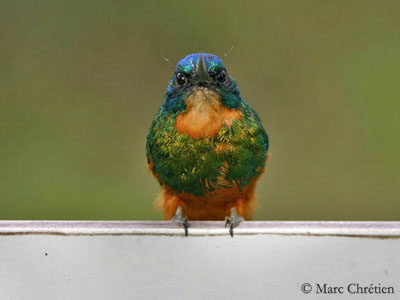
Female resembles male, but she has buffy-chestnut chin and throat. Her plumage is slightly duller than in male.
VOICE: SOUNDS BY XENO-CANTO
Green-tailed Jacamar’s call is a plaintive high-pitched “peer”, repeated twice or more. It also utters an occasional rhythmic “daw-dit-dot-dit”.
The song is an accelerating “peeo peeo peea pee-pee-pee-pee-pe-pe-pe-e-e-e-e,e,e,e” ending in trill, as most of other jacamars’ species.
HABITAT:
Green-tailed Jacamar frequents the shrubby edges of tall rainforest, gallery forest and secondary woodlands. It is also found in mangroves, shrubby areas and savannahs along streams or rivers and bushy marshlands.
It is visible from sea-level up to 700 metres of elevation.
RANGE:
Green-tailed Jacamar is sedentary in its range in eastern Colombia, southern and eastern Venezuela, the Guianas and northern Brazil.
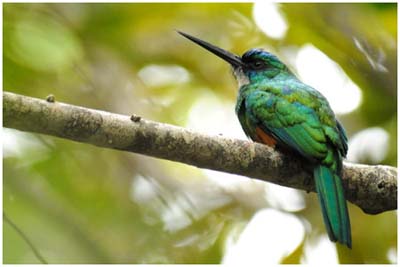
BEHAVIOUR:
Green-tailed Jacamar feeds mainly on insects of varied species.
They are often seen in pairs, hunting from exposed branches at forest edges. They perform aerial sallies for catching flying insects.
With help of its long bill, the Green-tailed Jacamar is able to catch butterflies and dragonflies through the wings, grasping firmly their bodies.
When it hunts for wasps and bees, the long bill still helps to maintain the stings away from its face, before to beat the insects against the branch.
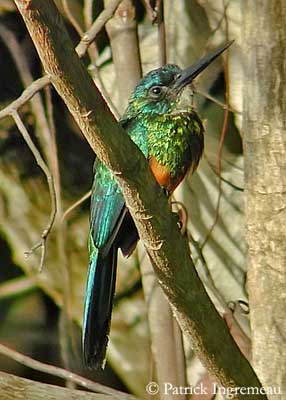
Green-tailed Jacamar is able to perform up to 40 aerial sallies per hour. It is very active when hunting, but between foraging flights, it rests motionless or only moving rapidly its head.
Green-tailed Jacamar is sedentary and defends its food resources in a territory occupied by a pair or a group.
Green-tailed Jacamar, as other jacamars, sings regularly during breeding season, and offers food to its mate.
FLIGHT:
Green-tailed Jacamar has swift flight, relatively short when it pursues its preys. Over longer distances, the bird flies with bursts of rapid wing beats followed by glides, giving an undulating flight.
REPRODUCTION:
Breeding season varies according to the range.
Green-tailed Jacamar nests in burrow, situated in low bank or arboreal termitary. The burrow is excavated by both sexes. The birds excavate with the bill, and debris are removed with the feet.
The unlined nest-chamber is at the end of the burrow. The burrow can be situated up to three metres above the ground.
The nesting behaviour of the Green-Tailed Jacamar is unknown. But this bird probably follows the same way that other jacamars, with incubation shared by both parents and chicks fed with insects by the adults.
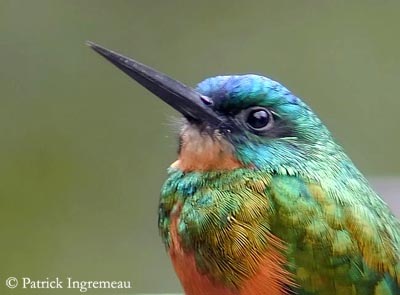
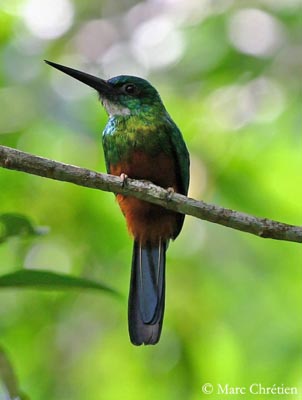
DIET:
Green-tailed Jacamar feeds mainly on insects of varied species, and also butterflies and dragonflies. It hunts from exposed perches, performing numerous sallies per hour.
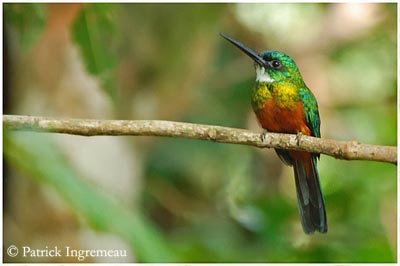
PROTECTION/ THREATS / STATUS:
Green-tailed Jacamar is common in the coastal parts of its range. It is very common in Surinam.
This species is not threatened at this moment.